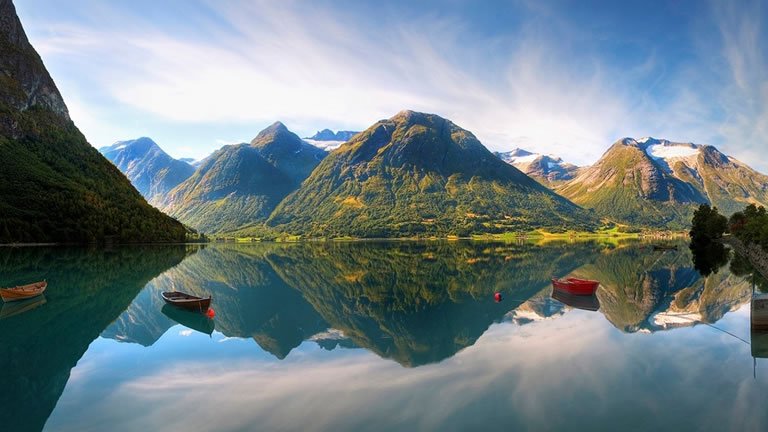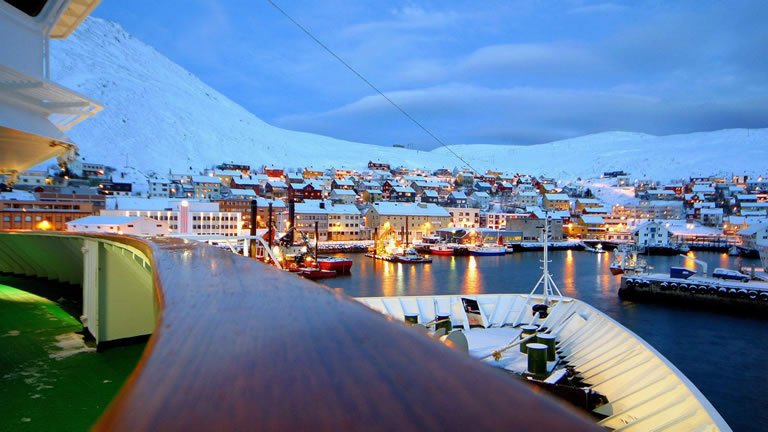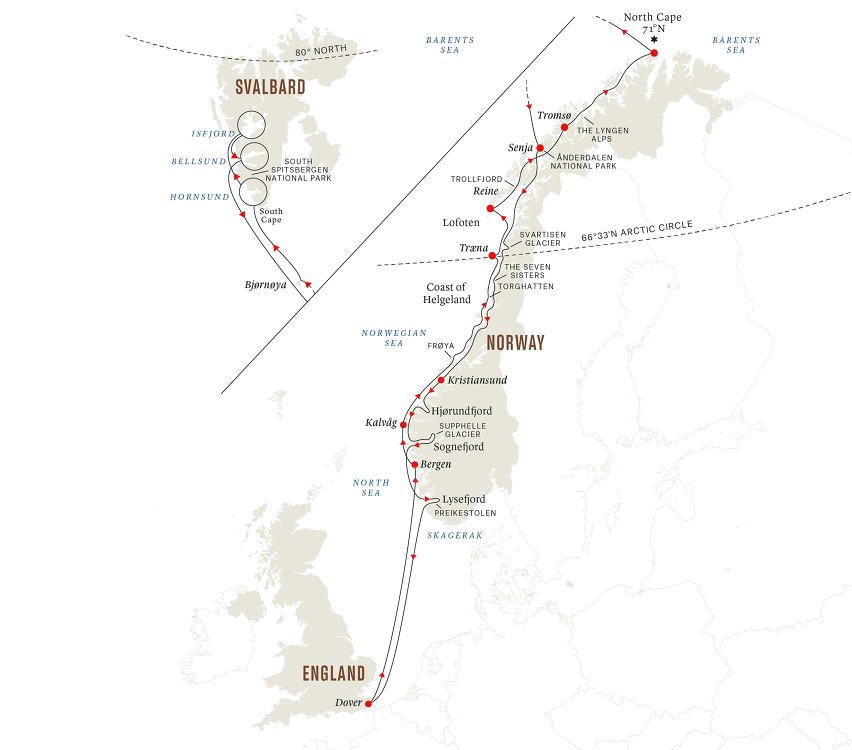Overview
Itinerary
All aboard at Dover! MS Maud is here, ready and waiting to bring you north toward Norway and ultimately Svalbard – the realm of the polar bear.
If you’ve time, take a walk alongside or atop the iconic white cliffs of Dover that have become a symbol for England. One of the best places to do so is at St. Margaret’s Bay which offers great views of the chalky coastline from its wide shingle beach.
Once on board the ship, you’ll pick up your complimentary expedition jacket, settle into your cabin, explore the ship and attend a mandatory safety drill. After the first of many delicious dinners and a welcome toast by the Captain, you’ll meet your expert Expedition Team.
They are your knowledgeable lecturers, warm hosts, and good-natured guides throughout your journey. First and foremost though, they are there to keep you safe and well. They’ll be making it a priority to run through important health and safety aspects with you and your fellow guests.
When the ship sets sail, we’ll pass the white cliffs of Dover and head up to the North Sea. Stretch your sea legs and get to know MS Maud, your cosy home away from home. If the weather holds, take in the salubrious sea air from out on deck.
Or park yourself in the Explorer Lounge and Bar to watch the world go by from the panoramic windows, maybe together with a relaxing glass of wine. Your adventure to the Norwegian coast and Svalbard is officially underway!
This day at sea gives you all the time you need to ease into your journey. You’ll definitely want to start enjoying onboard facilities like the hot tubs, sauna, and indoor gym. But you’ll likely also be striking up a camaraderie with the Expedition Team as well as other crew members and guests.
The Expedition Team will begin the first in their series of insightful lectures over at the Science Center. Each member of the Expedition Team are experts on different subjects and you’ll find them to be walking, talking treasure troves of stories and information.
They’ll share their extensive knowledge about the places, history, nature, people and natural phenomena we are likely to encounter during this cruise along the Norwegian coast. Today’s topics might include Norway's climate, the weather of the North Sea or the history of Hurtigruten as a national icon of Norway.
Depending on the weather when crossing the North Sea, we aim to arrive in Bergen in the evening, still having time to enjoy and explore this beautiful city. Founded in 1070 AD, Bergen was Norway’s capital for many years, and you’ll see that the city has retained a great deal of its local character, heritage and charm.
Your included activity in Bergen is an excursion to Mount Fløyen. We’ll hop on Hurtigruten buses from where the ship docks and drive to the Fløibanen funicular. The ride to the top of the mountain takes just six minutes. At the summit, 320 metres high, bask in stunning views over the city surrounded by seven mountains and the sea.
Once back in the centre of Bergen, spend some time wandering the cobblestone streets and alleyways of this thriving, compact city. If you want a taste of a local speciality, drop into one of the many cafés or pubs and order a half-litre of local Hansa beer.
Also, be sure to stroll through the historic UNESCO-listed Bryggen district with its colourful wooden wharfs. The area dates back to the 14th century and now houses boutique stores selling a range of Norwegian arts and crafts.
We welcome you to the little fishing village of Kalvåg, situated far out on the coastline with the open North Sea to the west. In the 1860s, it was one of the largest, if not the largest fishery on the Norwegian Coast, with as many as 11,000 people stationed there.
Today, only about 400 people live here, but it’s still the best-preserved fishing village in western Norway. No other expedition ships visit Kalvåg so you’ll experience an authentic slice-of-life community who will likely be thrilled to have visitors.
As part of our traditional Norwegian coastal voyage, our Captains have sailed these waters for decades, always wishing there was time to stop and show you around this oh-so-charming village. We’ve listened to their expert recommendation and that’s now exactly what you’ll get to do on this expedition cruise.
Admire an open-air art exhibition and walk around Kalvåg’s collection of old waterfront buildings, from restored wooden wharfs to herring salting warehouses. You may also go on optional excursions such as a hike of the area or kayaking.
Today you will get to explore the area around Mid-Norway windswept islands outside the coast of Trøndelag. Notice how the islands facing the North Sea are a stark contrast to the sheltered fjords, as you will see from the small trees here, bent by the strong wind.
This region of Norway lies at the heart of the Norwegian coast, both geographically and culturally. The beautiful city of Trondheim used to be the country’s capital and King Olav, later beatified as Saint Olav, is buried in the city’s Notre-Dame-inspired Nidaros Cathedral. King Olav fell during a battle at Stiklestad, also found along Trøndelag’s coast. His martyrdom there subsequently paved the way for the conversion of Norway from paganism to Christianity.
When Hurtigruten started sailing north of Trøndelag in 1893, much was still unknown about the coastline. Over the years, we’ve become experts in these waters. Today, we are the only ones with the maritime knowledge and skill to take you through the many skerries and islets, and past fjord after fjord.
Our plan is to explore one of the islands in this area. As part of an authentic adventure, it’s the weather that will determine our exact route and activities today. If the weather is pleasant, we can stay out among the islands along the coast. If otherwise, we can head into one of the sheltered bays.
Once the elements have helped us decide on our destination for the day, we’ll drop anchor and use our small exploration boats to get to shore. If conditions are right, you’ll be able to pick optional excursion hikes or kayaking, or possibly even both.
Frøya is one of the possible islands we will explore this day. It’s a resting, nesting and wintering area for many kinds of seabirds, like seagulls, cormorants, ducks and sea eagles. If we get to go ashore, you may also see seals, mink, otter, hare and deer.
In the morning, we sail along the coast of Helgeland with nothing but sky and sea ahead. In the distance, you can see mountains rise from the horizon. This is Træna, an archipelago of over 400 islands and islets right on the Arctic Circle. We plan to go on a scenic walk around the village of Husøya where most of Træna’s 454 inhabitants live.
Surprisingly, the community on the islands has a Nordic-Hawaiian vibe. This is inspired by decades-long correspondence between a local man who settled in Honolulu and the sister he never met in back in Træna. There is a permanent outdoor photography exhibition, themed café, and even a local ‘Waikiki Beach’.
Similar to Hawaiians, Norwegians believe in the life philosophy of friluftsliv – a respect for nature and a love of the outdoors. Being on an expedition with us is the best time not just to learn about this ideal, but to live it. And Træna is a perfect place for you to try a host of optional excursions.
Optional excursions might include island hopping, enjoying a sauna in an old boat house, observing sea eagles, tasting local fish or bathing in the Norwegian Sea. Or perhaps hike through a 700-metre-long tunnel in the dark, emerging at the top of the mountain for views of the entire Helgeland coast if the weather is clear.
There’s also Kirkhellern ‘Cathedral’ Cave on the island of Sanna. The acoustics make it ideal for a number of outdoor concerts but the main draw is archaeological evidence of human life in the cave as far back as 9,000 years ago.
As we leave Træna, we enjoy the evening with the dramatic Helgeland coastline as a backdrop. Listen to lectures from the Expedition Team on possible subjects like the Northern Lights, first settlements of Norway, Norwegian myths and fairy tales, or the Arctic Circle.
The approach to Lofoten is not to be missed as a formidable wall of mountains greets you. The islands here are unlike anything you’ve ever seen. The breathtaking scenery is a masterpiece of distinctive peaks, sheltered bays, untouched beaches, and paradisaic fishing villages.
We’ll land in idyllic Reine in the morning. You may recognise it as one of the most photographed nature landscapes in Norway – and for good reason. Characteristic red fishing huts known as rorbuer dot the shoreline against a backdrop of granite peak clusters jutting out of the fjord. As part of an included activity, you’ll board a bus to the picturesque old fishing village of Å, a unique, historical attraction. Here, you’ll see well-preserved houses, a blacksmith, an old cod liver oil press, and a bakery which might be making a fresh batch of lefse cakes. The local museum explains how cod fishing has been key to establishing Norway into a country.
From Reine, we sail to Trollfjord, a narrow waterway where vertical mountain walls loom above you. At the Captain’s discretion and depending on weather conditions in the area, you might get to experience the ship ‘threading the needle’ as it sails into the fjord so close to the cliff walls that you’ll feel you could reach out and brush them. Once safely within the fjord, the ship will then turn 360° on the spot. You’ll be holding your breath again as it manoeuvres back out through the tight entrance. It is a thrilling experience that requires superb seamanship. Thankfully, Hurtigruten Captains have that in spades!
We aim to be alongside in Tromsø – the capital of the Arctic - early in the morning, and you get to spend the entire day and evening exploring its fascinating history, culture and bold architecture.
The Arctic Cathedral is one of the most striking landmarks in Tromsø, especially when lit up at night. It features an attractive, huge stained-glass window that is well worth seeing up close.
Historically, Tromsø was a frontier town for returning hunters and explorers and acted as a launch point for several Arctic expeditions. Today, the city is often called the ‘Paris of the North’ because of its international and cultural diversity.
You can busy yourself by browsing the shops or sampling the region’s fresh produce in a range of restaurants. Feel like meeting some of the friendly locals? Tromsø is home to the world’s northernmost brewery, Mack Bryggeri, which also runs Ølhallen, a lively pub where townspeople go for a chat and a few pints.
Your included activity in Tromsø is a visit to the Polar Museum which is housed in a converted 1830s warehouse on the seafront. You’ll enjoy exhibitions that cover the city’s heritage as a base for famous trappers Henry Rudi and Wanny Wolstad, the first female hunter in Svalbard. Tromsø also played a crucial role in the expeditions of legendary explorers Fridtjof Nansen and Roald Amundsen.
Other activities available in Tromsø include optional excursions with our Expedition Team on nature hikes and scenic bus rides. Being this far north, you may actually see the Northern Lights directly overhead, so spending some time out on deck when we leave town, may prove truly rewarding.
Start the day by arriving at the small town of Skarsvåg. You’ll now visit one of the northernmost points in Europe as part of an included excursion.
The scenic bus ride passes small bays and tiny villages, then crosses a mountain plateau before arriving at spectacular North Cape. At 71°10’21´N, it is just 2,100 kilometres away from the Geographic North Pole, with only the Svalbard Archipelago in between.
Stand at the cliff’s edge and gaze out across the sparkling sea. The North Cape is the closest you may ever get to the top of the world. There’s the obligatory selfie at the Globe Monument to snap before visiting the North Cape Hall for several exhibits and a short film which chronicle the history of the cape.
Your included visit to the North Cape can also be combined with experiences on the island of Magerøya. As this is the home of many fishermen, the local restaurants have the best ingredients available for seafood dishes, and king crabs are available all year round.
This is also the home to hundreds of sea eagles, who congregate in large numbers around the bird rocks of Gjesværstappan. You can explore the fishing village at your leisure, or you can join the Expedition Team on an optional hike to “Kirkeporten” view point.
About midway between the Norwegian mainland and Spitsbergen, you arrive at Bjørnøya, or Bear Island in English. Don’t get too excited about its name though. The island is more renown for the birdlife that flock here over summer rather than any sightings of polar bears.
Except for a small area hosting a meteorological station established in 1918, the entire island is a nature reserve. The northern and middle parts of the island are mainly flat and dominated by shallow lakes – approximately 1200 of them scattered around. The landscape starts to get more mountainous further south of the island with the Misery mountain peaking at 536 m.
There is a reason why photos of the coasts of Bear Island tend to fill up the SD cards of many travellers – they are spectacular! The constant surf has forged several striking rock columns and caves. The coastal cave Perleporten is immediately recognisable. Tall, near-vertical cliffs engulf the southern tip of the island, making for some fantastic views.
If wind and weather conditions allow, we may go ashore for hikes and do small boat cruising. You may even get to go kayaking in an optional activity.
Today you will get to explore the wonderfully varied landscape and geology of Hornsund, which is a part of the South Spitsbergen National Park.
The rugged, steep mountains, breathtaking fjords and rich, colourful vegetation of the park make it one of the most spectacular natural corners of the world. A layer of mist covers most of the highest peaks, but on a clear day, you may see the towering Hornsundtind, reaching 1,431 m above sea level.
One of the possible lecture topics on this day is the polar bear. That’s not a coincidence; the chance to see polar bears is simply another reason why a visit to Hornsund is so special. Other animals to keep an eye out for are walruses, seals, reindeer and arctic foxes.
The natural beauty of Hornsund is not within easy reach of traditional cruise ships, which tend to leave it out. Our custom-made explorer vessels allow us to attempt landings where other ships can’t, giving you a better chance of seeing 25-km long Hornsund up close.
Depending on weather and sea ice, there are also optional excursions such as hikes, kayaking and small boat cruising to enjoy.
Get into explorer mode, because today you sail into the remarkable Isfjord, the second-longest fjord in Svalbard. Leading out to many smaller fjords, it forms a lush and beautiful system rich in wildlife and vegetation. Prepare to see immense U-shaped valleys which were carved out of the mountains by giant glaciers some ten thousand years ago.
To the north of the fjord, Alkehornet is a prominent landmark. It’s an imposing example of carbonate rock, with a horn-shaped mount at its peak. Arctic fox can be spotted here, as well as stately Svalbard reindeer.
It is noticeable how well traces of early human presence have been preserved in Isfjorden. Cultural remains of Svalbard’s whaling and hunting heritage can be found along the beaches and bays.
A more modern cultural icon is located further south of the fjords. Here lie the buildings of the famous Isfjord Radio station, a former radio and weather station established in 1933 that now serves as one of the most beautifully situated hotels in the world.
The landscape of the inner parts of Isfjorden is constantly changing, but we have several good landing sites in this area, and we will decide where to go and what to do based upon weather and ice conditions when we arrive.
Not to be confused with its narrower cousin, the fjord, Bellsund is a 20 km long sound. Sounds tend to be wider than fjords and are usually formed by the flooding of river valleys.
Seeing the sound’s snow-capped mountains, glaciers and striking geological formations, you’d be forgiven to think that the name ‘Bellsund’ means ‘beautiful sound’. However, Bellsund actually borrows its name from the bell-shaped mountain Klokkefjellet at the mouth of the sound.
You might catch sight of migrating Svalbard reindeer, grazing the lush vegetation that is richly fertilised by droppings from the seabirds above - just the circle of life at work!
Bellsund has a long history with hunting and trapping, and these traditions are being kept alive still at Akseløya. One of the stories the expedition team may recount in the hunters and trappers lecture is that of 1930s Wanny Woldstad – a taxi driver who became the first female arctic trapper.
Cultural remains from other periods of Svalbard’s history can be seen throughout Bellsund. The ruins from the 1900s mining settlements are still visible, and you can see them as we spend the day exploring the area in landings, hikes and optional kayaking activities, if weather conditions allow.
Your discovery of Svalbard is over, and we have started our journey back south. We cross the Barents Sea, named after the Dutch explorer Willem Barentsz, who discovered Spitsbergen and Bear Island.
You can spend your time unwinding in the Explorer Lounge & Bar, soaking in the hot tub or enjoy the vastness of the never-ending horizon. When darkness falls and if the sky is clear, there are good chances of experiencing the dancing Northern Lights above you as well.
If you’re hungry for more knowledge, the Expedition Team continues their onboard lecture series, possibly talking about the battle of the Barents Sea during World War II.
Spend some time in the Science Center and possibly learn some useful tricks to expedition photography to be able to capture the aurora on your camera.
Today, we dock at Senja, one of the most ruggedly beautiful and less-visited islands in Norway. You’ll be awestruck by the scenery on display here and understand why it made CNN travel’s list for ’10 of the world’s most beautiful islands’.
The captain will decide on a location to drop anchor or a port where we can dock and go ashore for walks. Optional excursions may include guided hikes or kayaking. Should weather be rough on the outer coastal side, we’ll seek shelter in the bays or inlets.
Sometimes referred to as ‘Norway in miniature’, the island boasts diverse landscapes that seem to change in the blink of an eye. Senja’s northern coastline is characterised by lofty mountains plummeting straight into the sea, interspersed with isolated coves and sandy beaches that fringe crystal clear turquoise waters.
Southern Senja is distinguished by rocky coastline and pine forests and is home to Ånderdalen National Park. The eastern side of Senja has gentler, more forgiving landscapes with rolling hills and birch forests.
We’ll be sailing the Holandsfjord off the Helgeland Coast today and will arrive at Svartisen. Covering 370 square kilometres, it has 60 glacier tongues and is Norway’s second largest glacier after Jostedalsbreen.
Svartisen is actually made up of two separate glaciers Vestisen and the Østisen which are divided by the one-kilometre long Vesterdalen valley.
‘Svartisen’ means ‘black ice’, which you’ll see sort of describes the characteristically deep colour of the ice, ranging from turquoise and dark blue, but never quite black.
Despite being the lowest lying glacier on the European continent before the last Ice Age retreat, Svartisen is surrounded by the Saltfjell mountain range, one of the largest in Norway. You might spot some of the mountains over 1,500 metres high; Snøtinden in the west, Sniptinden and Istinden in the east.
Our aim for the day is to land on the local jetty and visit the Svartisen Glacier Museum. You’ll also have opportunities to do optional excursions near the glacier and its surroundings. From Svartisen you will also see the Engen glacier, which can be reached on an extended optional excursion hike.
We dock at Kristiansund which is one of the most densely populated cities in Norway. Its urban area is spread across four islands with bustling waterfronts, scenic marinas and distinctive architecture, decorated in shades of red, yellow and green.
Kristiansund is also known as Norway’s ‘Dried Cod Capital’ because of its historic export of salted fish or bacalao, known locally as klippfisk. If you’re interested in the topic, head to the local Norwegian Bacalao Museum housed in a 250-year-old building.
You will go on a guided walking tour and experience all this small city has to offer. There are also optional excursions to sign up for, including kayaking with local guides or a hike with the Expedition Team.
There’s also an optional excursion to the famous Atlantic Ocean Road, an 8km scenic drive, with eight uniquely designed, undulating bridges linking a series of islands.
Like famous Geirangerfjord next door, Hjørundfjord is part of the UNESCO designated Fjords Norway area which is notable for “exceptional natural beauty”. Surrounded by the Sunnmøre Alps with peaks soaring 1,700 metres straight up from the sea, it is one of the most scenic fjords in all of Norway and still undiscovered by most other cruise lines.
On a clear day, you’ll get the full 360° sensory experience: the bluest skies, the coniferous forests, perhaps in fall foliage and grazing pastures covering the mountainsides. The still, pristine waters then reflect the superb scenery in all its glory, merging the fjord and landscape perfectly.
We anchor close to a settlement in the fjord, possibly Urke, and a local tender boat will take you ashore to experience Norwegian nature and culture.
Sign up for optional excursions to explore the area further. Join a guided walk taking in villages along the Hjørundfjord and learn about the history, nature and royal connections of this splendid beauty spot.
Alternatively, you can opt for more exhilarating, pulse-raising excursions such as hiking up the mountain for incredible views. Or find yourself kayaking along the fjord, the exquisite silence broken only by the sound of your own paddle.
In the morning we sail into Sognefjorden, nicknamed the ‘King of the Fjords’, as it is the longest and deepest fjord in Norway. Stretching 205 kilometres inland from the coast, we plan to cruise deep into the fjord to the tiny hamlet of Fjærland.
Only 300 people live here, and you get to go ashore to discover this idyllic village with many charming old buildings. Fjærland is a designated Norwegian Book Town, and picturesque second-hand book shops and stands can be found all over the small village. But Fjærland is not all about books.
This is also the place where Sognefjorden meets one of Norway’s best-known glaciers, Jostedalsbreen. It’s the largest glacier on the European continent and has several smaller glacier arms stretching out in many directions, including Bøyabreen and Supphellebreen.
This makes Fjærland a perfect place to learn more about how glaciers created the beautiful fjords of Norway, which makes a visit to the Norwegian Glacier Museum a perfect included activity of the day.
At the award-winning museum, designed by world famous architect Sverre Fehn, you’ll engage with hands-on exhibits that explain why glacier ice is blue and how the fjords were formed. You can even perform a few experiments with 1,000 year-old glacier ice and watch a panoramic film about Europe’s largest glacier.
Early in the morning we reach the Stavanger area and the highlight of the day, Lysefjord. It is 40 km long, up to 422 metres deep and boasts some of the most striking vertical cliffs of all the Norwegian fjords.
We sail as deep as possible into imposing Lysefjord towards the iconic viewpoint at Preikestolen. Preikestolen, also known as Pulpit Rock, is perhaps the most famous tourist attraction in Norway and the popular subject of many social media posts.
As we approach Preikestolen, we hope to be treated to a fine view of this incredible rock formation from below. We might also see the equally renown Kjæragbolten where a giant boulder seems precariously wedged in a mountain crevasse.
If conditions allow, you’ll have an optional excursion to do a five-hour guided hike with the Expedition Team to the Preikestolen viewpoint 604 metres above Lysefjord.
Should you prefer to stay on the ship, you can spend time out on deck drinking in the magnificent scenery, looking up at the majestic mountains towering above you.
After a scenic cruise of the fjord and collecting our tired but exhilarated hikers, it’ll be time for us to set sail for Dover, sadly leaving the fjords, islands, and eventually the coast as a whole behind.
Sadly, it’s our last day at sea and our adventure is drawing to a close. As we cross the North Sea, you may spot seabirds and dolphins that like to follow the ship.
Make the most of your day on board Maud. You may want to soak your tired limbs in the hot tub, work out in the gym, relax in the Explorer lounge, or edit the photographs from your trip.
Don’t miss the Expedition Team as they review the highlights of your memorable fall expedition cruise to the Svalbard archipelago and the coast of Norway.
We pass the white cliffs of Dover during the early morning hours and dock at the city’s harbour. After breakfast, it’s time to leave your home for the past 21 days.
As you head home, you’ll take with you the unforgettable memories of Svalbard and Norway’s magnificent fjords along the west coast.
Dover acts as the gateway to English countryside, the verdant counties of Kent and Surrey, and beyond to the melting pot of London. But before you rush off, you might to like to visit Dover Castle, tipped to be the largest in England.
There is a rare Roman lighthouse here, one of only three in the world and reputedly the UK’s oldest building. You can also go on a tour of the underground hospital and secret WWII tunnels that run beneath the castle complex.
Whatever’s next for you, we wish you a safe onward journey and look forward to seeing you on your next adventure!
Life Onboard MS Maud

Revitalised with Scandinavian touches and innovative technology for sustainable expeditions in complete comfort. Read more

A dedicated team of specialists accompanies every expedition and serves as your hosts on board and ashore. Read more
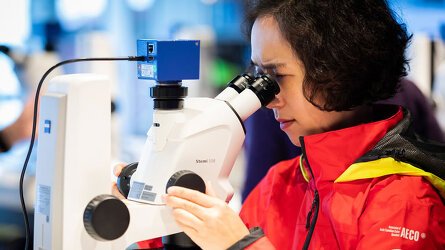
Join fascinating lectures and interactive workshops in the Science Centre, HQ for the expert Expedition Team. Read more

Three onboard restaurants feature menus with locally sourced ingredients, taking guests on a tantalising culinary journey. Read more
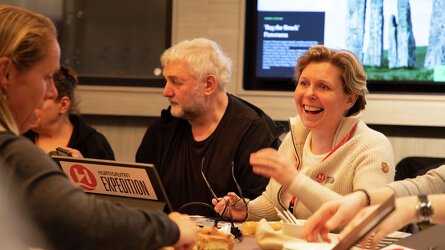
The sentiment of 'hygge' is embraced by Hurtigruten and the onboard atmosphere is welcoming, warm, and famously relaxed. Read more
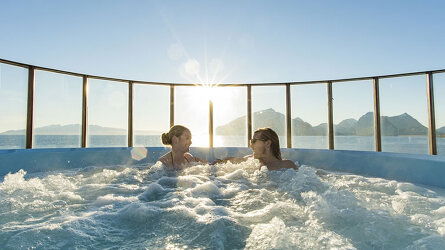
Enjoy the wellness facilities on board, including outdoor hot tubs, a sauna, and treatment rooms to indulge in a massage. Read more

Availability Click on prices below to view cabin upgrades and details
Tour & cruises prices are per person. Prices shown have savings applied, are subject to availability and may be withdrawn at any time without notice. Prices and trip information are correct at the time at this point in time, however are subject to confirmation at the time of booking and are subject to change by Hurtigruten. For cruise itineraries, cabin images are sourced from Hurtigruten. These should be treated as indicative only. Cabin inclusions, upholsteries and room layout may differ to the image(s) shown depending on the ship selected and your sailing dates.
Similar Cruises
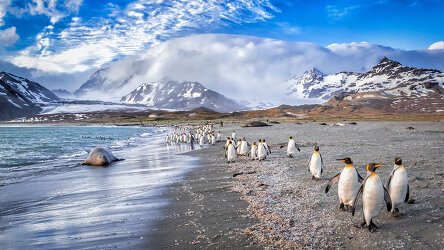
23 Days Buenos Aires Santiago
Operated By: Hurtigruten

23 Days Santiago Santiago
Operated By: Hurtigruten
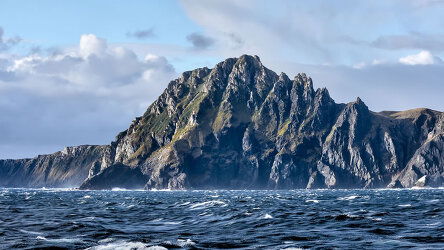
23 Days Santiago Valparaiso
Operated By: Hurtigruten
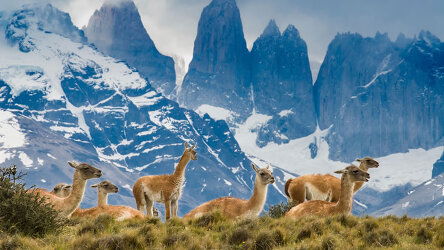
22 Days Valparaiso Santiago
Operated By: Hurtigruten
